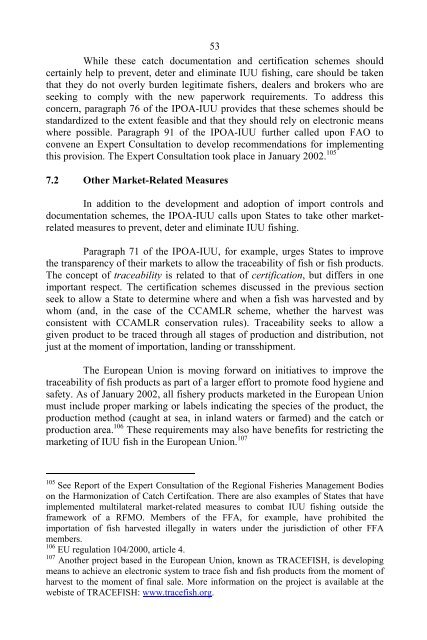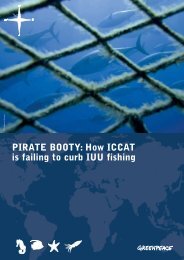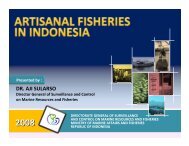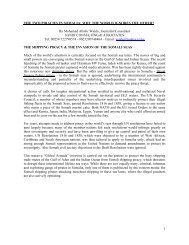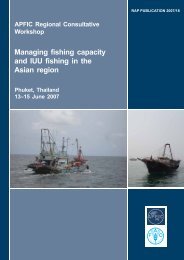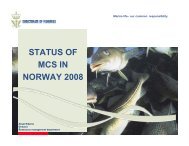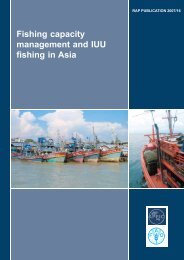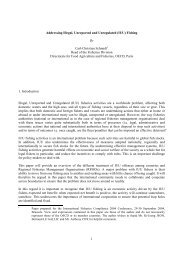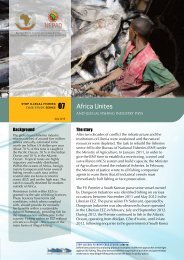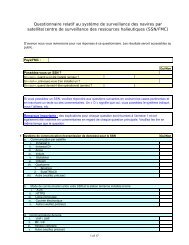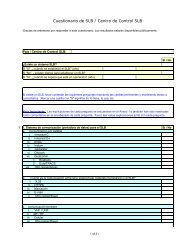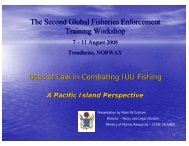53While these catch documentation and certification schemes shouldcertainly help to prevent, deter and eliminate <strong>IUU</strong> fishing, care should be takenthat they do not overly burden legitimate fishers, dealers and brokers who areseeking to comply with the new paperwork requirements. To address thisconcern, paragraph 76 <strong>of</strong> the <strong>IPOA</strong>-<strong>IUU</strong> provides that these schemes should bestandardized to the extent feasible and that they should rely on electronic meanswhere possible. Paragraph 91 <strong>of</strong> the <strong>IPOA</strong>-<strong>IUU</strong> further called upon FAO toconvene an Expert Consultation to develop recommendations for implementingthis provision. The Expert Consultation took place in January 2002. 1057.2 Other Market-Related MeasuresIn addition to the development and adoption <strong>of</strong> import controls anddocumentation schemes, the <strong>IPOA</strong>-<strong>IUU</strong> calls upon States to take other marketrelatedmeasures to prevent, deter and eliminate <strong>IUU</strong> fishing.Paragraph 71 <strong>of</strong> the <strong>IPOA</strong>-<strong>IUU</strong>, for example, urges States to improvethe transparency <strong>of</strong> their markets to allow the traceability <strong>of</strong> fish or fish products.The concept <strong>of</strong> traceability is related to that <strong>of</strong> certification, but differs in oneimportant respect. The certification schemes discussed in the previous sectionseek to allow a State to determine where and when a fish was harvested and bywhom (and, in the case <strong>of</strong> the CCAMLR scheme, whether the harvest wasconsistent with CCAMLR conservation rules). Traceability seeks to allow agiven product to be traced through all stages <strong>of</strong> production and distribution, notjust at the moment <strong>of</strong> importation, landing or transshipment.The European Union is moving forward on initiatives to improve thetraceability <strong>of</strong> fish products as part <strong>of</strong> a larger effort to promote food hygiene andsafety. As <strong>of</strong> January 2002, all fishery products marketed in the European Unionmust include proper marking or labels indicating the species <strong>of</strong> the product, theproduction method (caught at sea, in inland waters or farmed) and the catch orproduction area. 106 These requirements may also have benefits for restricting themarketing <strong>of</strong> <strong>IUU</strong> fish in the European Union. 107105 See Report <strong>of</strong> the Expert Consultation <strong>of</strong> the Regional Fisheries Management Bodieson the Harmonization <strong>of</strong> Catch Certifcation. There are also examples <strong>of</strong> States that haveimplemented multilateral market-related measures to combat <strong>IUU</strong> fishing outside theframework <strong>of</strong> a RFMO. Members <strong>of</strong> the FFA, for example, have prohibited theimportation <strong>of</strong> fish harvested illegally in waters under the jurisdiction <strong>of</strong> other FFAmembers.106 EU regulation 104/2000, article 4.107 Another project based in the European Union, known as TRACEFISH, is developingmeans to achieve an electronic system to trace fish and fish products from the moment <strong>of</strong>harvest to the moment <strong>of</strong> final sale. More information on the project is available at thewebiste <strong>of</strong> TRACEFISH: www.tracefish.org.
54States can also combat <strong>IUU</strong> fishing through the dissemination <strong>of</strong>information to individuals and companies in their territories whose activities arerelated to fishing. Paragraph 73 <strong>of</strong> the <strong>IPOA</strong>-<strong>IUU</strong> calls on States to make suchindividuals and companies (“importers, transshippers, buyers, consumers,equipment suppliers, bankers, insurers, other services suppliers and the public”)aware <strong>of</strong> the detrimental effects <strong>of</strong> doing business with vessels identified asengaged in <strong>IUU</strong> fishing. Similarly, paragraph 74 calls on States to make theirfishers aware <strong>of</strong> the detrimental effects <strong>of</strong> doing business with others who dobusiness with <strong>IUU</strong> fishers. 108To fulfil these commitments, States could undertake publicitycampaigns using various media, including notices to the public, press releasesand targeted communications to relevant industry groups. Paragraphs 73 and 74also suggest that States could enact legislation that makes it a violation toconduct such business or to trade in fish or fish products derived from <strong>IUU</strong>fishing. Such legislation could be drafted along the lines <strong>of</strong> the model providedin footnote 25, supra, which is repeated here for the sake <strong>of</strong> convenience:A person subject to the jurisdiction <strong>of</strong> [State] who –(a) on his own account, or as partner, agent or employee <strong>of</strong>another person, lands, imports, exports, transports, sells, receives,acquires or purchases; or(b) causes or permits a person acting on his behalf, or usesa fishing vessel, to land, import, export, transport, sell, receive,acquire or purchase,any fish taken, possessed, transported or sold contrary to the law <strong>of</strong>another State or in a manner that undermines the effectiveness <strong>of</strong>conservation and management measures adopted by a RegionalFisheries Management Organization shall be guilty <strong>of</strong> an <strong>of</strong>fenceand shall be liable to pay a fine not exceeding (insert monetaryvalue).108 A number <strong>of</strong> RFMOs have also called on their members to take such measures. In1999, for example, the IOTC adopted a Resolution 99/02 (“Actions Against FishingActivities by Large-scale Flag <strong>of</strong> Convenience Longline Vessels”), which, among otherthings, called on IOTC members to urge importers and others in the market chain torefrain from any transactions involving this catch and to educate the public not topurchase product derived from this catch. ICCAT Resolution 99-11 contains very similarlanguage. Japan has provided guidance to its importers, transporters and equipmentmanufacturers, asking them to refrain voluntarily from conducting business with vesselsidentified by ICCAT as undermining ICCAT’s measures. See M. Komatsu, supra note 20.
- Page 4 and 5:
iiiPREPARATION OF THIS DOCUMENTThe
- Page 6 and 7:
vThe IPOA-IUU is voluntary. However
- Page 8 and 9:
viii6.2 Examples of some port State
- Page 10 and 11:
xiBACKGROUND1. From ancient times,
- Page 12 and 13:
xiii11. The Code is voluntary. Howe
- Page 14 and 15:
1. INTERNATIONAL PLAN OF ACTION - I
- Page 16 and 17: 3Since the late 1990s, a number of
- Page 18 and 19: 5(1) conducted by national or forei
- Page 20 and 21: 7flag States, coastal States and Po
- Page 22 and 23: 9In light of this, the very first
- Page 24 and 25: 11the vessels rarely if ever visit
- Page 26 and 27: 13For example, Japan requires its n
- Page 28 and 29: 15IUU fishing on the high seas. 27
- Page 30 and 31: 17end all forms of government econo
- Page 32 and 33: 19developing States, 36 have introd
- Page 34 and 35: 21If the vessel is fishing on the h
- Page 36 and 37: 23registering a vessel that has a h
- Page 38 and 39: 25RFMOs have a role to play in ensu
- Page 40 and 41: 27FAO, in turn, will make available
- Page 42 and 43: 29species can be caught, what gear
- Page 44 and 45: 31Flag States are also encouraged t
- Page 46 and 47: 33cases, fishing vessels registered
- Page 48: 35light of this, paragraph 51 of th
- Page 51 and 52: 38transshipment at sea is prohibite
- Page 53 and 54: 40supported IUU fishing. For exampl
- Page 55 and 56: 42Japan prohibits port calls by tun
- Page 57 and 58: 44of a NAFO member, it must be insp
- Page 59 and 60: 46discussed in Section 7 of these g
- Page 61 and 62: 48products harvested through IUU fi
- Page 63 and 64: 50products. On the basis of that da
- Page 65: 52question, while the latter only c
- Page 69 and 70: 56RFMOs engage in IUU fishing. No s
- Page 71 and 72: 588.3 Possibilities for Further Act
- Page 73 and 74: 60resolutions calling on those memb
- Page 75 and 76: 62landings, port control, and inspe
- Page 77 and 78: 648.3.8 Actions in Response to Rema
- Page 79 and 80: 66As a result, IUU fishers often co
- Page 81 and 82: 68A number of other developed State
- Page 83 and 84: 702.4 Measures to control transport
- Page 85 and 86: 10.3 Suggested Format for Reports t
- Page 87 and 88: 74Flag States should closely contro
- Page 89 and 90: 76A coastal State should consider r
- Page 91 and 92: 78To assist States in implementing
- Page 93 and 94: 12. LITERATURE CITED80Agnew, D.J. 2
- Page 95 and 96: 82Greenpeace. 2001. Pirate Fishing:
- Page 97 and 98: 84II. NATURE AND SCOPE OF IUU FISHI
- Page 99 and 100: 86to the Conservation and Managemen
- Page 101 and 102: National Legislation88Legislation16
- Page 103 and 104: 90National Plans of Action25. State
- Page 105 and 106: 9236.2 having taken into account al
- Page 107 and 108: 9446.3 the species, fishing gear au
- Page 109 and 110: 9651.2 cooperation and exchange of
- Page 111 and 112: 98general operating guidelines for
- Page 113 and 114: 100and should consider measures to
- Page 115 and 116: 10280.9 development of observer pro
- Page 117 and 118:
10486.3 the strengthening of region
- Page 119 and 120:
106Articles V, VI, and VII of the A
- Page 121 and 122:
1084.2 To the greatest extent pract
- Page 123 and 124:
110• Compliance with other aspect
- Page 125 and 126:
1126. Information regarding such si
- Page 127 and 128:
114Annex ACommon English Name Scien
- Page 129 and 130:
1164. Parties shall consider and ac
- Page 131 and 132:
118Committed to take steps, consist
- Page 133 and 134:
1209. An export-validated Dissostic
- Page 135:
122APPENDIX VIWEBSITES OF SELECTED


